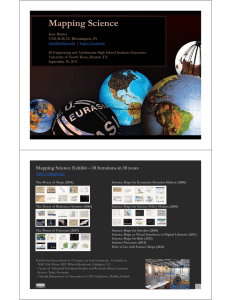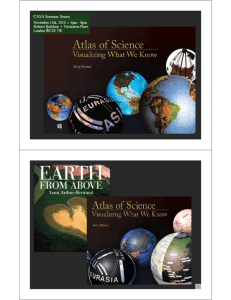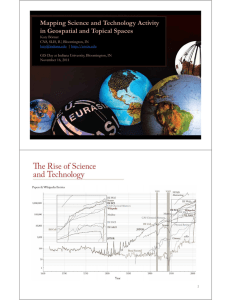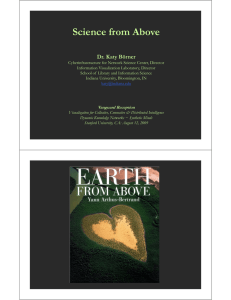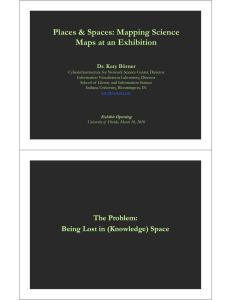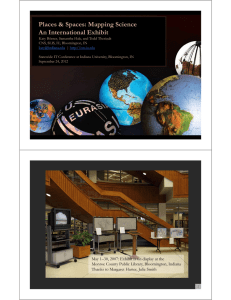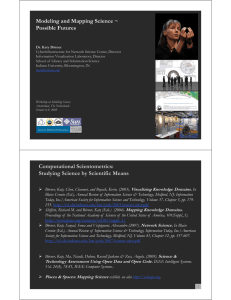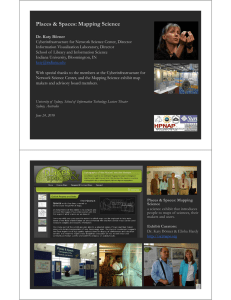Science from Above Dr Katy Börner Dr. Katy Börner
advertisement
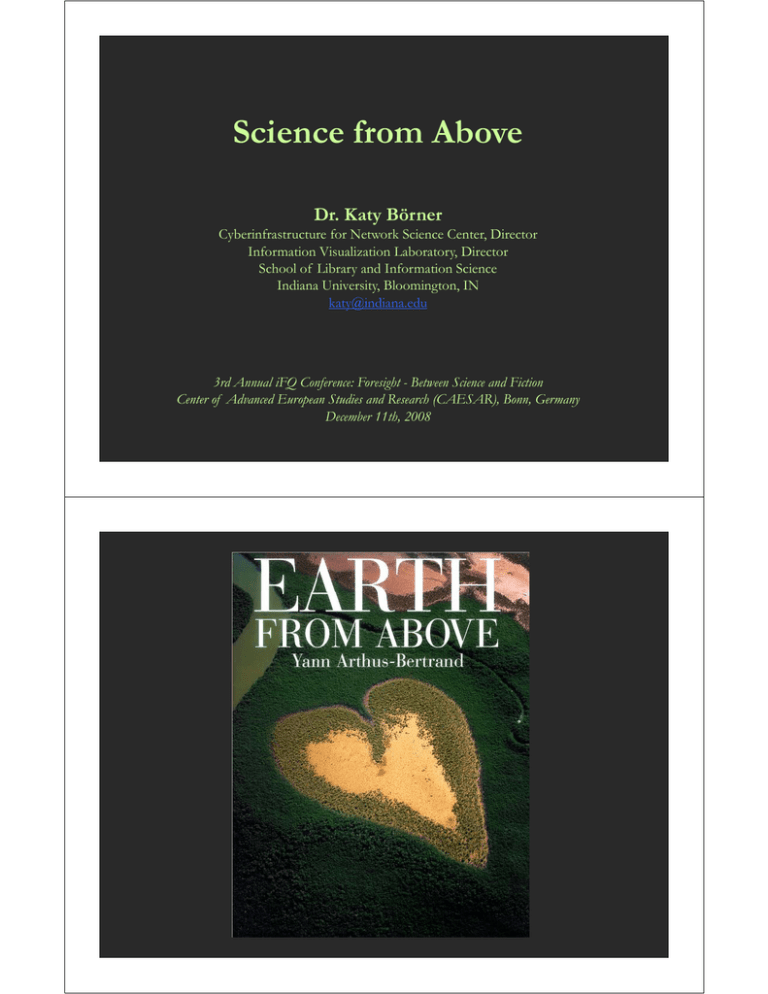
Science from Above Dr Katy Börner Dr. Cyberinfrastructure for Network Science Center, Director Information Visualization Laboratory, Director School of Library and Information Science Indiana University, Bloomington, IN katy@indiana.edu 3rd Annual iFQ Conference: Foresight - Between Science and Fiction Center of Advanced European Studies and Research (CAESAR), (CAESAR) Bonn Bonn, Germany December 11th, 2008 Th Problem: The P bl Being Lost in (Knowledge) Space 15th Century: One person can make major contributions to many areas of science Mankind’s Knowledge use Human Brain contribute Amount of knowledge on brain can mange Leonardo Da Vinci (1452-1519) 20th Century: One person can make major contributions to a few areas of science Mankind’s Knowledge use Human Brain contribute Amount of knowledge on brain can mange Albert Einstein (1879-1955 ) 21th Century: One person can make major contributions to a specific area of science Mankind’s Knowledge use contribute Amount of knowledge on brain can mange Human Brain 21th Century: One person can make major contributions to a specific area of science Mankind’s Knowledge use Human Brains contribute Amount of knowledge on brain can mange Manager Domain Expert Humanity’s Knowledge The Great Wave Off Kanagawa (Katsushika Hokusai, 1760-1849) Growth of Scientific Knowledge, 1665 to 2006 2005 World Population The population map uses a quarter degree box resolution. Boxes with zero people are given in white. Darker shades of red indicate higher population counts per box using a logarithmic interpolation. The highest density boxes appear in Mumbai, Mumbai with 11 11,687,850 687 850 people in the quarter degree block block, Calcutta (10 (10,816,010), 816 010) and Shanghai (8,628,088). 2003 Scientific Productivity Shown is where science is performed today. Each circle indicates a geographic location at which scholarly papers are published. The larger the circle the more papers are produced. Boston, MA, London, England, and New York NY are the top three paper production areas York, areas. Note the strong resemblance with the Night on Earth and the IP Ownership maps and the striking differences to the world population map. 2007 IP Address Ownership This map shows IP address ownership by location. Each owner is represented by a circle and the area size of the circle corresponds to the number of IP addresses owned. The larges circle denotes MIT’s holdings of an entire class A subnet, subnet which equates to 16,581,375 16 581 375 IP addresses. addresses The countries that own the most IP addresses are US (560 million), Japan (130 million), Great Britain (47 million). M Mapping i Science S i E Exhibit hibi Places & Spaces: Mapping Science a science exhibit that introduces people to maps of sciences, their makers k andd users. Exhibit Curators: Dr. Katy Börner & Elisha Hardy http://scimaps.org 15 Mapping Science Exhibit – 10 Iterations in 10 years http://scimaps.org/ The Power of Maps (2005) Science Maps for Economic Decision Makers (2008) The Power of Reference Systems (2006) Science Maps for Science Policy Makers (2009) Science Maps for Scholars (2010) Science Maps as Visual Interfaces to Digital Libraries (2011) Science Maps for Kids (2012) Science Forecasts (2013) The Power of Forecasts (2007) How to Lie with Science Maps (2014) Exhibit has been shown in 49 venues on four continents. 16 Th Power The P r off Maps M p Four Early Maps of Our World VERSUS Si E Six Early l M Maps off S Science i (1st Iteration of Places & Spaces Exhibit - 2005) How would a map of science look? What metaphors p would work best? Th Power The P r off Reference R f r n Systems S t m Four Existing Reference Systems VERSUS Si P Six Potential i lR Reference f S Systems off S Science i (2nd Iteration of Places & Spaces Exhibit - 2006) How would a reference system for all of s i n look? science l k? What dimensions would it have? The Power of Forecasts F Four Existing E i ti F Forecasts t VERSUS Six Potential Science ‘Weather’ Weather Forecasts (3rd Iteration of Places & Spaces Exhibit - 2007) Can one forecast science? What ‘science forecast language’ g g will work? http://www.scotese.com/ http://www.weather.gov Named Storms, available online at http://svs.gsfc.nasa.gov/vis/a000000/a003200/a003279 Science Maps for Economic Decision Making Four Existing Maps VERSUS Six Science Maps (4th Iteration of Places & Spaces Exhibit - 2008) What insight needs to economic decision makers m k rs h have?? What data views are most useful? Science Maps for Science Policy Makers Four Existing Maps Call For Maps for 5th Iteration of Exhibit VERSUS Six Science Maps Submit initial entry: January 9th, 2009 Notification to mapmakers: p JJanuaryy 31st, 2009 Submit final entries: March 31, 2009 5th Iteration ready for ? ? April ? display: ? ? 30th, 2009 ? ? ? ? ? See http://scimaps.org/cfs.php for details on how to submit. Vi i http://scimaps.org/host Visit h // ith /h for f info i f on how h to host h exhibit. hibi (5 Iteration of Places & Spaces Exhibit - 2009) Additional Elements of the Exhibit Illuminated Diagram Display Hands--on Science Maps for Kids Hands Worldprocessor Globes Illuminated Diagram Display W. Bradford Paley, Kevin W. Boyack, Richard Kalvans, and Katy Börner (2007) Mapping, Illuminating, and Interacting with Science. SIGGRAPH 2007. Questions: p Who is doingg research on what topic and where? What is the ‘footprint’ of interdisciplinary research fields? p have scientists? What impact Large-scale, high resolution prints illuminated via projector or screen. Interactive touch panel. Contributions: Interactive, high resolution interface to access and make sense of data about scholarly activity. 48 Hands--on Science Maps for Kids Hands All maps of science are on sale via http://scimaps.org/ordermaps/ Science Puzzle Map for Kids by Fileve Palmer, Julie Smith, Elisha Hardy and Katy Börner, Indiana University, 2006. (Base map taken from Illuminated Diagram display by Kevin Boyack, Richard Klavans, and W. Bradford Paley.) Activities: Solve the puzzle. Navigate to ‘Earth Science’. Identify major inventions. Place major inventors. Find your dream job on the map. Why is mathematics important? Winners @ AMSE JoHanna Sanders, age 12, a picture of someone enjoying nature and a theme that science is all around us. Sascha Richey, age 8, drew a picture of her mother and explained why her mother is her favorite scientist. Where to go from here? Contact the map makers via the exhibit curators: K Börner Katy B ((k (katy@indiana.edu k @ d katy@indiana.edu) d ) andd El Elisha h Hardy H d (efhardy@indiana.edu efhardy@indiana.edu)) Computational Scientometrics: S d i S Studying Science i b by S Scientific i ifi M Means B Börner, Katy, K Chen, Ch Chaomei, Ch i andd Boyack, B k Kevin. K i (2003). (2003) Visualizing Vi li i K Knowledge l d D Domains. i In I Blaise Cronin (Ed.), Annual Review of Information Science & Technology, Medford, NJ: Information Today, Inc./American Society for Information Science and Technology, Volume 37, Chapter 5, pp. 179255. http://ivl.slis.indiana.edu/km/pub/2003-borner-arist.pdf p // / /p / p Shiffrin, Richard M. and Börner, Katy (Eds.) (2004). Mapping Knowledge Domains. Proceedings of the National Academy of Sciences of the United States of America, 101(Suppl_1). http://www.pnas.org/content/vol101/suppl_1/ Börner, Bö Katy, K t Sanyal, S l Soma S andd Vespignani, V pi i Al Alessandro d (2007). (2007) Network N t k Science. S i I Blaise In Bl i Cronin (Ed.), Annual Review of Information Science & Technology, Information Today, Inc./American Society for Information Science and Technology, Medford, NJ, Volume 41, Chapter 12, pp. 537-607. http://ivl.slis.indiana.edu/km/pub/2007-borner-arist.pdf p p p Places & Spaces: Mapping Science exhibit, see also http://scimaps.org. 72 Cyberinfrastructures for a Science of Science Scholarly Database of 18 million scholarly records https://sdb.slis.indiana.edu Information Visualization Cyberinfrastructure http://iv.slis.indiana.edu Network Workbench Tool and Community Wiki *NEW* Scientometrics plugins http://nwb.slis.indiana.edu Epidemics Cyberinfrastructure http://epic.slis.indiana.edu/ 73 http://sci.slis.indiana.edu http://cns.slis.indiana.edu http://ella.slis.indiana.edu/~katy http://scimaps.org http://cns.slis.indiana.edu The End.
